Numerical Study on the Influence of Rivers on the Urban Microclimate: A Case Study in Chengdu, China
Abstract
:1. Introduction
- This study mainly focuses on the influence of inland rivers on the microclimate of Chengdu.
- The influence mechanism of rivers, trees, and roads on the urban riverfront space of an inland city is analyzed.
- Outdoor predicted mean vote (PMV) is used to evaluate the influence of rivers, trees, and green plants on the outdoor thermal comfort of urban riverfront spaces.
2. Data and Methodology
2.1. Study Area
2.2. Meteorological Data Acquisition
2.3. ENVI-Met Modeling and Parameter Settings
2.4. Validation of ENVI-Met Simulation Results
3. Results and Discussions
3.1. The Simulation Results of Air Temperature
3.2. The Simulation Results of Relative Air Humidity
3.3. The Simulation Results of Thermal Comfort in the Study Area
4. Conclusions
- (1)
- The river had a significant cooling effect on air temperature in the riverfront spaces. The temperature in the downwind region was lower than that of the upwind region. Conversely, the road had a warming effect on the air temperature. The order of influence of different underlying surfaces on air temperature was determined as: rivers > roads > trees.
- (2)
- The river had an obvious humidifying effect on the relative air humidity, while the road had little effect. The order of influence of different underlying surfaces on the relative air humidity was determined as: rivers > trees > roads.
- (3)
- The PMV results showed that the thermal comfort on the left bank was better than that on the right bank. Rivers, trees, and green plants play a crucial role in alleviating the urban heat islands and regulating the local microclimate.
Author Contributions
Funding
Data Availability Statement
Acknowledgments
Conflicts of Interest
References
- Sun, S.; Xu, X.; Lao, Z.; Liu, W.; Li, Z.; García, E.; He, L.; Zhu, J. Evaluating the impact of urban green space and landscape design parameters on thermal comfort in hot summer by numerical simulation. Build. Environ. 2017, 123, 277–288. [Google Scholar] [CrossRef]
- Kjellstrom, T.; Holmer, I.; Lemke, B. Workplace heat stress, health and productivity-an increasing challenge for low and middle-income countries during climate change. Glob. Health Action 2009, 2, 2047. [Google Scholar] [CrossRef]
- Lai, A.; Maing, M.; Ng, E. Observational studies of mean radiant temperature across different outdoor spaces under shaded conditions in densely built environment. Build. Environ. 2017, 114, 397–409. [Google Scholar] [CrossRef]
- Watanabe, S.; Nagano, K.; Ishii, J.; Horikoshi, T. Evaluation of outdoor thermal comfort in sunlight, building shade, and pergola shade during summer in a humid subtropical region. Build. Environ. 2014, 82, 556–565. [Google Scholar] [CrossRef]
- Fang, Z.; Feng, X.; Xu, X.; Zhou, X.; Lin, Z.; Ji, Y. Investigation into outdoor thermal comfort conditions by different seasonal field surveys in China, Guangzhou. Int. J. Biometeorol. 2019, 63, 1357–1368. [Google Scholar] [CrossRef]
- Niu, J.; Liu, J.; Lee, T.; Lin, Z.; Mak, C.; Tse, K.T.; Tang, B.S.; Kwok, K.C.S. A new method to assess spatial variations of outdoor thermal comfort: Onsite monitoring results and implications for precinct planning. Build. Environ. 2015, 91, 263–270. [Google Scholar] [CrossRef] [Green Version]
- Chen, L.; Ng, E. Outdoor thermal comfort and outdoor activities: A review of research in the past decade. Cities 2012, 29, 118–125. [Google Scholar] [CrossRef]
- Ng, E.; Cheng, V. Urban human thermal comfort in hot and humid Hong Kong. Energy Build. 2012, 55, 51–65. [Google Scholar] [CrossRef]
- Odhiambo, M.R.O.; Abbas, A.; Wang, X.; Elahi, E. Thermo-Environmental assessment of a heated venlo-type greenhouse in the Yangtze River delta region. Sustainability 2020, 12, 10412. Available online: https://ideas.repec.org/a/gam/jsusta/v12y2020i24p10412-d461184.html (accessed on 12 December 2020). [CrossRef]
- Santamouris, M.; Cartalis, C.; Synnefa, A.; Kolokotsa, D. On the impact of urban heat island and global warming on the power demand and electricity consumption of buildings—A review. Energy Build. 2015, 98, 119–124. [Google Scholar] [CrossRef]
- Xue, S.; Xiao, Y. Study on the outdoor thermal comfort threshold of Lingnan garden in summer. Procedia Eng. 2016, 169, 422–430. Available online: http://creativecommons.org/licenses/by-nc-nd/4.0/ (accessed on 31 October 2016). [CrossRef]
- Yang, X.; Peng, L.; Jiang, Z.; Chen, Y.; Yao, L.; He, Y.; Xu, T. Impact of urban heat island on energy demand in buildings: Local climate zones in Nanjing. Appl. Energy 2020, 260, 114279. [Google Scholar] [CrossRef]
- Anjos, M.; Targino, A.C.; Krecl, P.; Oukawa, G.Y.; Braga, R.F. Analysis of the urban heat island under different synoptic patterns using local climate zones. Build. Environ. 2020, 185, 107268. [Google Scholar] [CrossRef]
- Zheng, H.; Chen, Y.; Pan, W.; Cai, Y.; Chen, Z. Impact of land use/Land cover changes on the thermal environment in urbanization: A case study of the natural wetlands distribution area in Minjiang River estuary, China. Pol. J. Environ. Stud. 2019, 28, 3025–3041. Available online: http://www.pjoes.com/pdf-93743-37097?filename=37097.pdf (accessed on 5 March 2019). [CrossRef]
- Moyer, A.N.; Hawkins, T.W. River effects on the heat island of a small urban area. Urban Clim. 2017, 21, 262–277. [Google Scholar] [CrossRef]
- Li, X.; Koh, T.Y.; Entekhabi, D.; Roth, M.; Panda, J.; Norford, L.K. A multi-resolution ensemble study of a tropical urban environment and its interactions with the background regional atmosphere. J. Geophys. Res. Atmos. 2013, 118, 1–15. [Google Scholar] [CrossRef]
- Morakinyo, T.E.; Lau, K.K.-L.; Ren, C.; Ng, E. Performance of Hong Kong’s common trees species for outdoor temperature regulation, thermal comfort and energy saving. Build. Environ. 2018, 137, 157–170. [Google Scholar] [CrossRef]
- Teshnehdel, S.; Akbari, H.; Giuseppe, E.D.; Brown, R.D. Effect of tree cover and tree species on microclimate and pedestrian comfort in a residential district in Iran. Build. Environ. 2020, 178, 106899. [Google Scholar] [CrossRef]
- Park, M.; Hagishima, A.; Tanimoto, J.; Narita, K. Effect of urban vegetation on outdoor thermal environment: Field measurement at a scale model site. Build. Environ. 2012, 56, 38–46. [Google Scholar] [CrossRef]
- Zhang, B.; Xie, G.; Gao, J.; Yang, Y. The cooling effect of urban green spaces as a contribution to energy-saving and emission-reduction: A case study in Beijing, China. Build. Environ. 2014, 76, 37–43. [Google Scholar] [CrossRef]
- Cao, X.; Onishi, A.; Chen, J.; Imura, H. Quantifying the cool island intensity of urban parks using ASTER and IKONOS data. Landsc. Urban Plan. 2010, 96, 224–231. [Google Scholar] [CrossRef]
- Evans, J.M.; Schiller, S.D. Application of microclimate studies in town planning: A new capital city, an existing urban district and urban river front development. Atmos. Environ. 1996, 30, 361–364. [Google Scholar] [CrossRef]
- Xie, Q.; Li, J. Detecting the Cool Island Effect of Urban Parks in Wuhan: A City on Rivers. Int. J. Environ. Res. Public Health 2021, 18, 132. [Google Scholar] [CrossRef]
- Cai, Z.; Han, G.; Chen, M. Do water bodies play an important role in the relationship between urban form and land surface temperature? Sustain. Cities Soci. 2018, 39, 487–498. [Google Scholar] [CrossRef]
- Deng, Q.; Zhou, Z.; Li, C.; Yang, G. Influence of a railway station and the Yangtze River on the local urban thermal environment of a subtropical city. J. Asian Archit. Build Eng. 2022, 21, 589–604. [Google Scholar] [CrossRef]
- Piccolroaz, S.; Toffolon, M.; Robinson, C.T.; Siviglia, A. Exploring and Quantifying River Thermal Response to Heatwaves. Water 2018, 10, 1098. [Google Scholar] [CrossRef] [Green Version]
- Du, H.; Song, X.; Jiang, H.; Kan, Z.; Wang, Z.; Cai, Y. Research on the cooling island effects of water body: A case study of Shanghai, China. Ecol. Indic. 2016, 67, 31–38. [Google Scholar] [CrossRef]
- Cruz, J.A.; Blanco, A.C.; Garcia, J.J.; Santos, J.A.; Moscoso, A.D. Evaluation of the cooling effect of green and blue spaces on urban microclimate through numerical simulation: A case study of Iloilo River Esplanade, Philippines. Sustain. Cities Soc. 2021, 74, 103184. [Google Scholar] [CrossRef]
- Xiong, Y.; Zhang, J.; Xu, X.; Yan, Y.; Sun, S.; Liu, S. Strategies for improving the microclimate and thermal comfort of a classical Chinese garden in the hot-summer and cold-winter zone. Energy Build. 2020, 215, 109914. [Google Scholar] [CrossRef]
- Hathway, E.A.; Sharples, S. The interaction of rivers and urban form in mitigating the Urban Heat Island effect: A UK case study. Build. Environ. 2012, 58, 14–22. [Google Scholar] [CrossRef] [Green Version]
- Iakovoglou, V.; Gounaridis, D.; Zaimes, G.N. Riparian areas in urban settings: Two case studies from Greece. Int. J. Innov. Sus. Develop. 2013, 7, 271–288. [Google Scholar] [CrossRef]
- Norton, B.A.; Coutts, A.M.; Livesley, S.J.; Harris, R.J.; Hunter, A.M.; Williams, N.S.G. Planning for cooler cities: A framework to prioritise green infrastructure to mitigate high temperatures in urban landscapes. Landsc. Urban Plan. 2015, 134, 127–138. [Google Scholar] [CrossRef]
- Konarska, J.; Uddling, J.; Holmer, B.; Lutz, M.; Lindberg, F.; Pleijel, H.; Thorsson, S. Transpiration of urban trees and its cooling effect in a high latitude city. Int. J. Biometeorol. 2016, 60, 159–172. Available online: https://link.springer.com/article/10.1007/s00484-015-1014-x (accessed on 6 June 2015). [CrossRef] [PubMed]
- Tominaga, Y.; Sato, Y.; Sadohara, S. CFD simulations of the effect of evaporative cooling from water bodies in a micro-scale urban environment: Validation and application studies. Sustain. Cities Soc. 2015, 19, 259–270. [Google Scholar] [CrossRef]
- Xu, X.; Liu, S.; Sun, S.; Zhang, W.; Liu, Y.; Lao, Z.; Guo, G.; Smith, K.; Cui, Y.; Liu, W.; et al. Evaluation of energy saving potential of an urban green space and its water bodies. Energy Build. 2019, 188–189, 58–70. [Google Scholar] [CrossRef]
- Yang, X.; Peng, L.L.H.; Chen, Y.; Yao, L.; Wang, Q. Air humidity characteristics of local climate zones: A three-year observational study in Nanjing. Build. Environ. 2020, 171, 106661. [Google Scholar] [CrossRef]
- Steeneveld, G.J.; Koopmans, S.; Heusinkveld, B.G.; Theeuwes, N.E. Refreshing the Role of Open Water Surfaces on Mitigating the Maximum Urban Heat Island Effect. Landsc. Urban Plan. 2014, 121, 92–96. [Google Scholar] [CrossRef]
- Zhang, P.; Zhang, X.; Ma, Z.; Song, J. Numerical Study on the Affection of River System of Different Areas to Thermal Environment of Residential Neighborhood. Adv. Mater. Res. 2012, 433–440, 1422–1427. Available online: https://www.scientific.net/AMR.433-440.1422 (accessed on 15 January 2012). [CrossRef]
- Wang, J.; Meng, Q.; Tan, K.; Zhang, L.; Zhang, Y. Experimental investigation on the influence of evaporative cooling of permeable pavements on outdoor thermal environment. Build. Environ. 2018, 140, 184–193. [Google Scholar] [CrossRef]
- Hwang, R.L.; Lin, T.P.; Matzarakis, A. Seasonal effects of urban street shading on long-term outdoor thermal comfort. Build. Environ. 2011, 46, 863–870. [Google Scholar] [CrossRef]
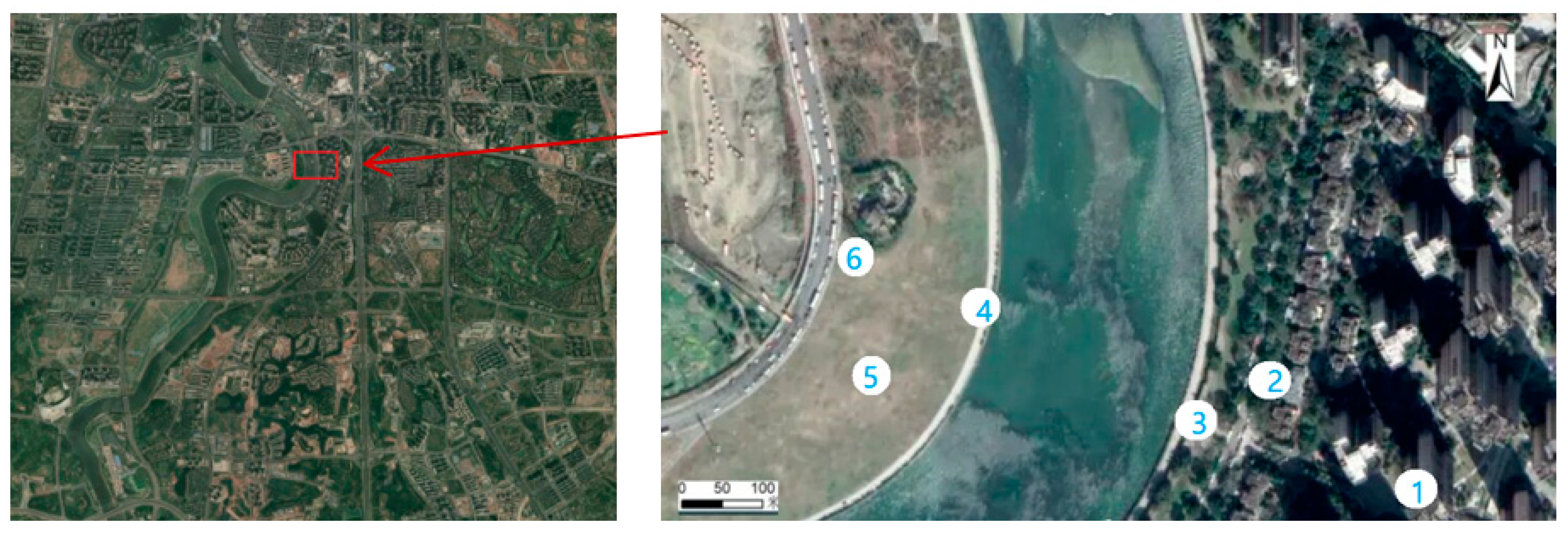
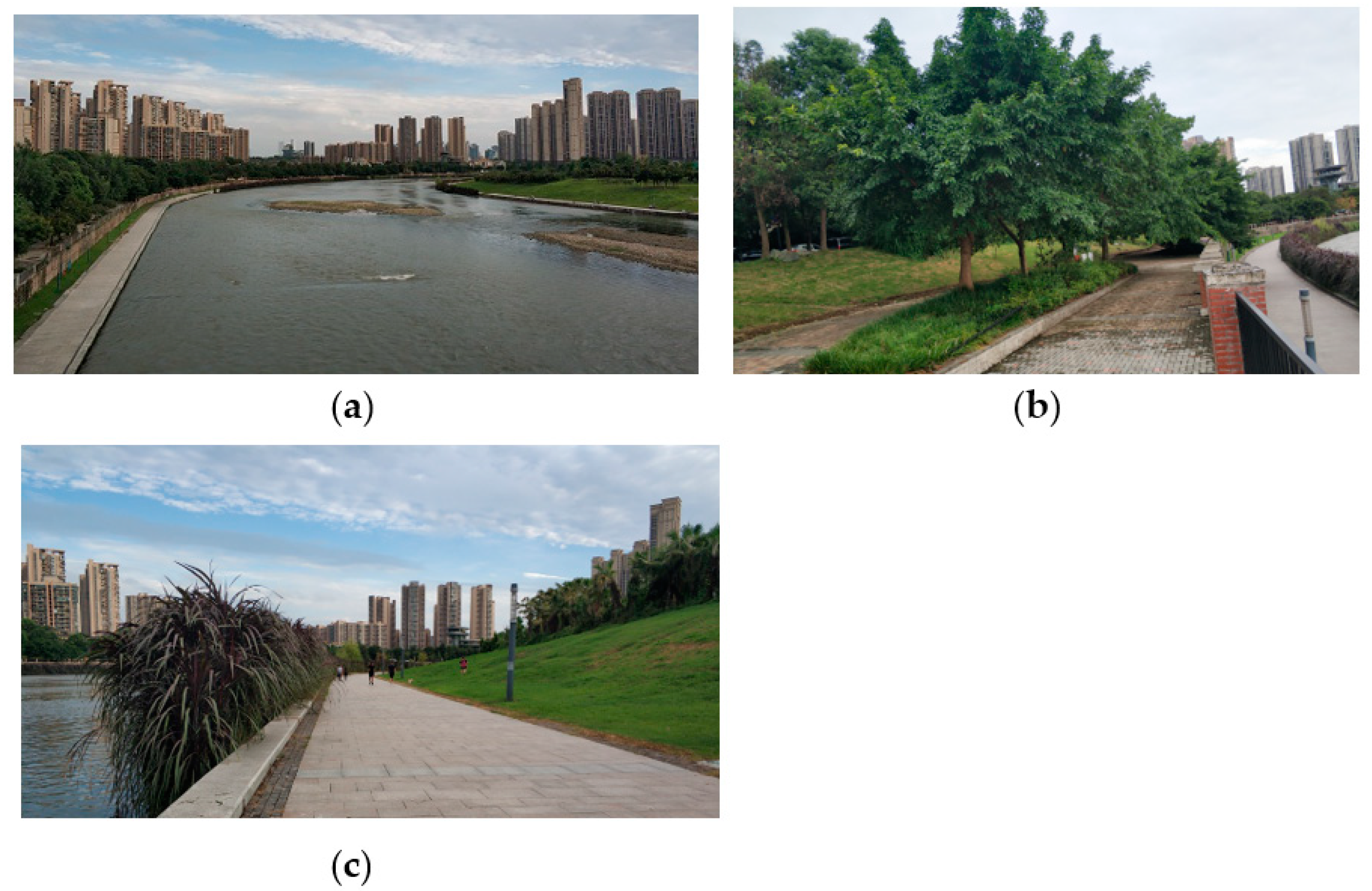
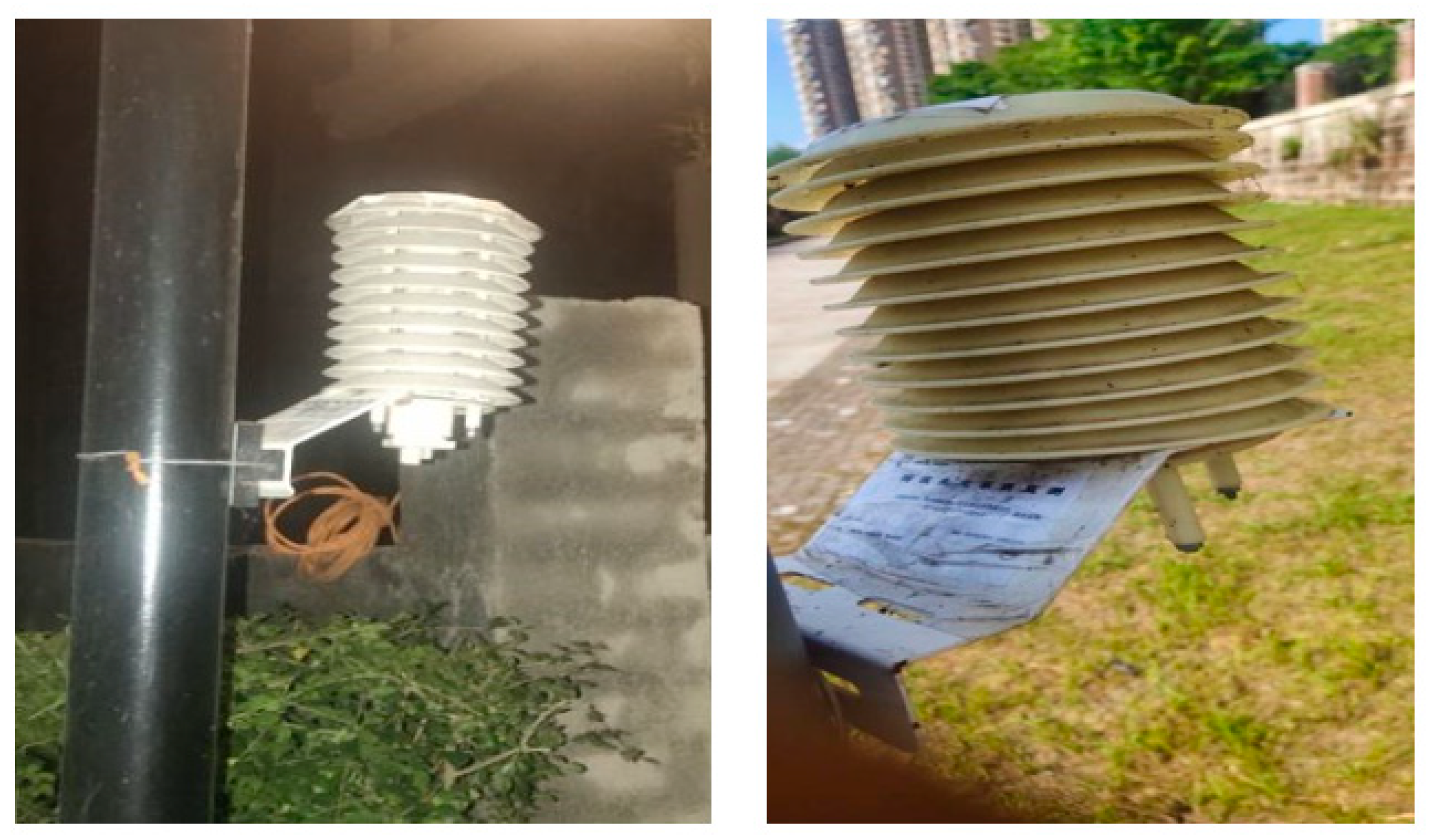
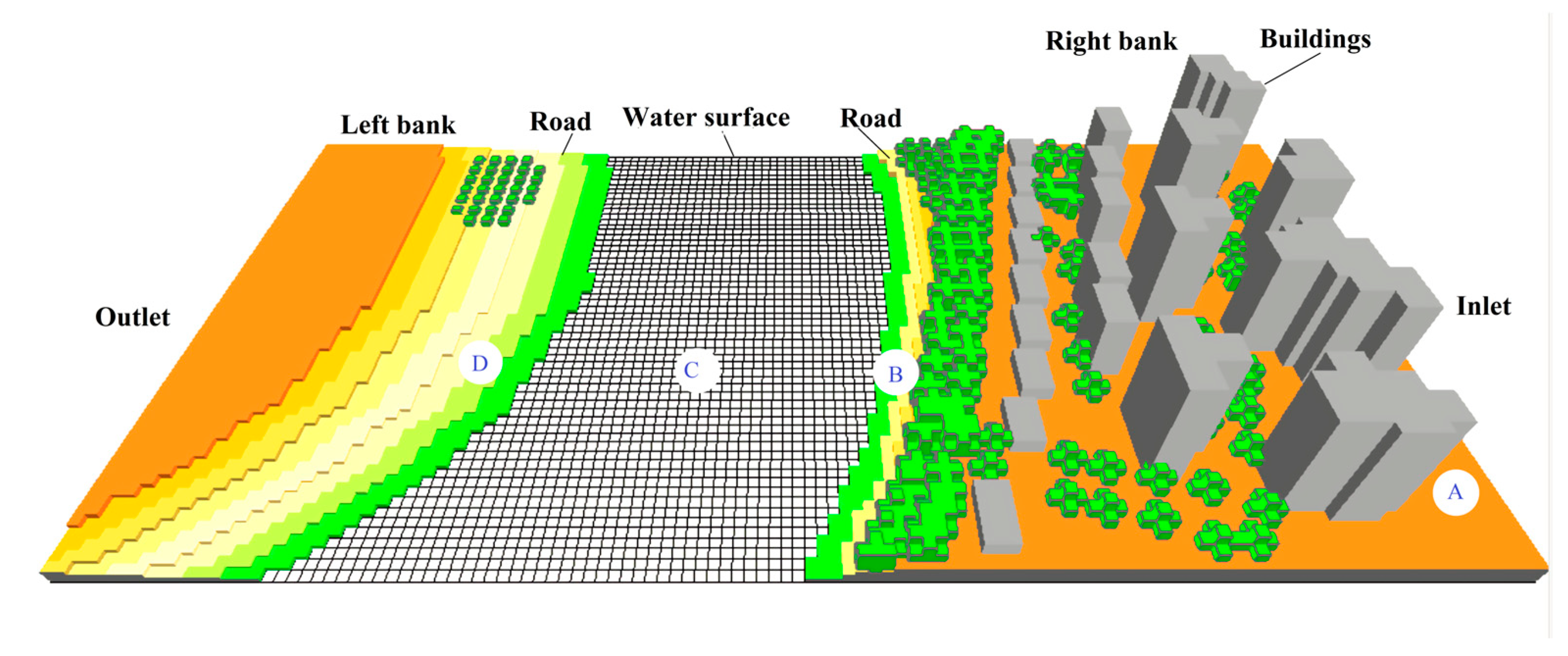
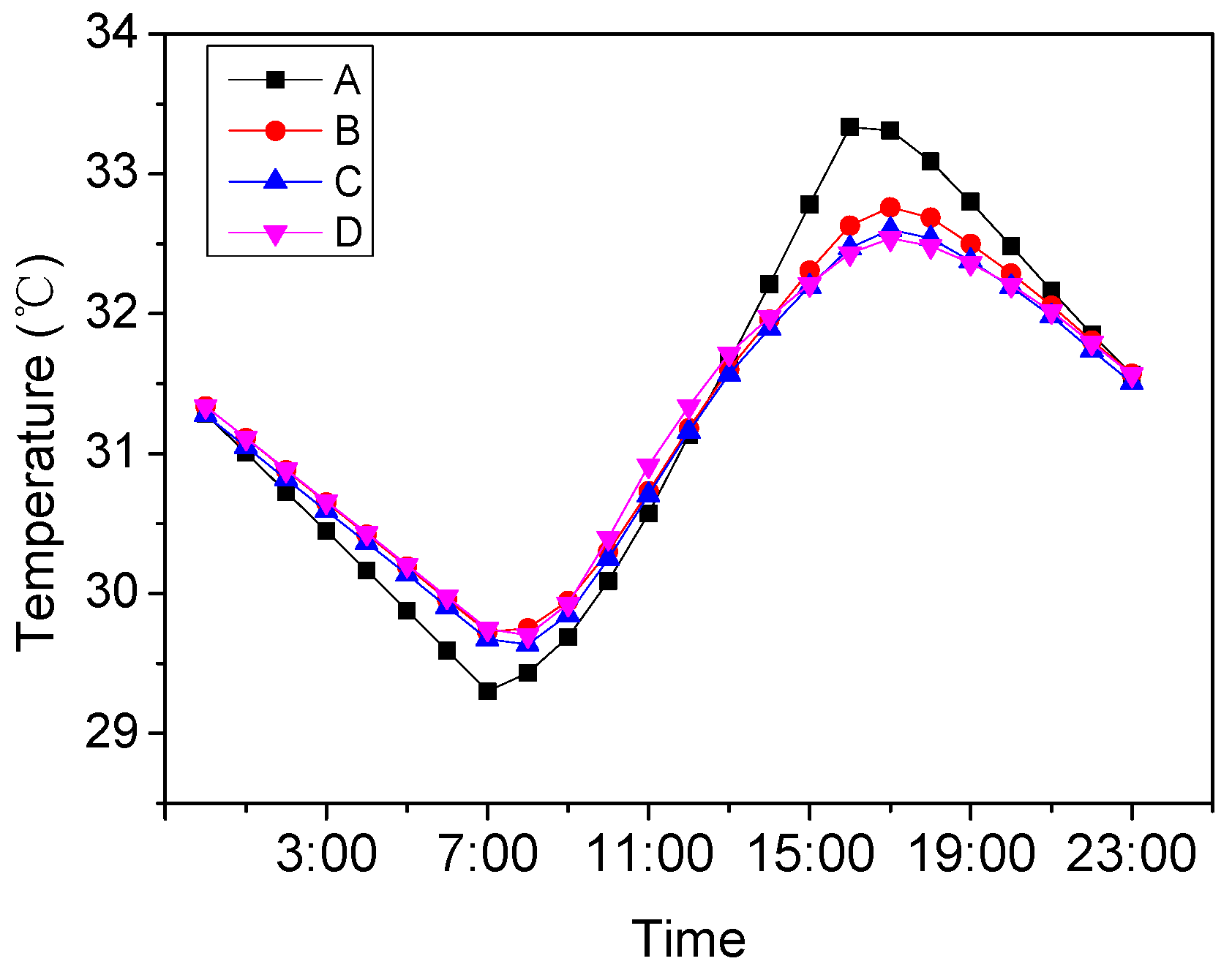
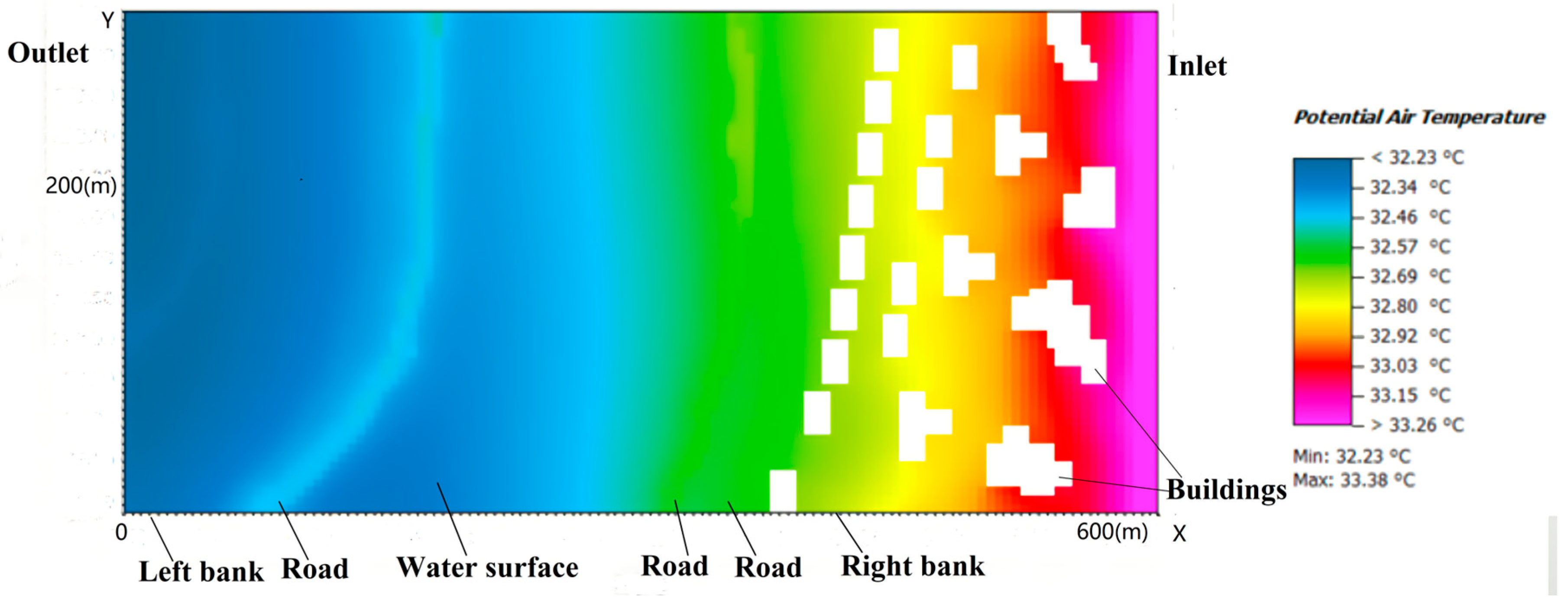
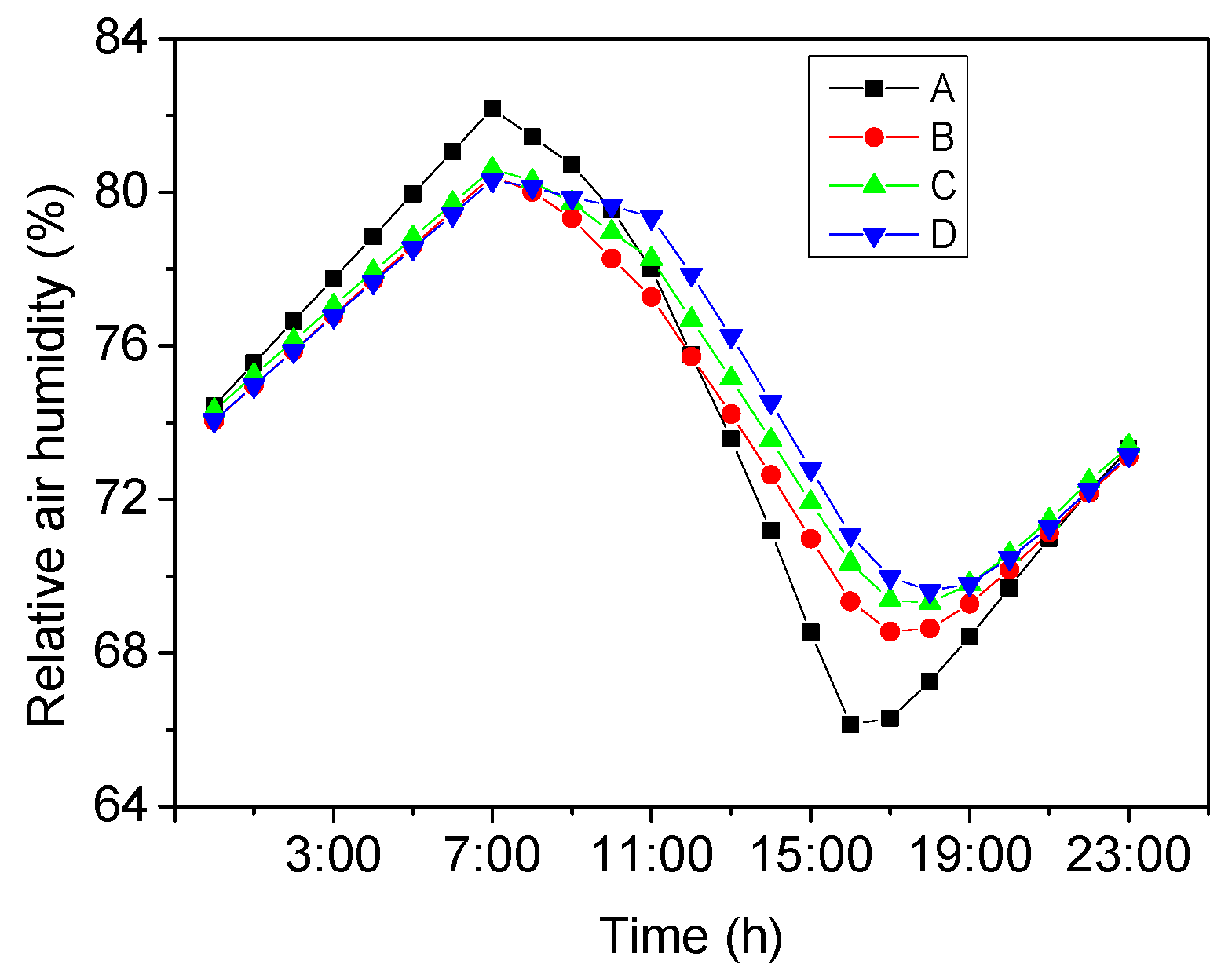
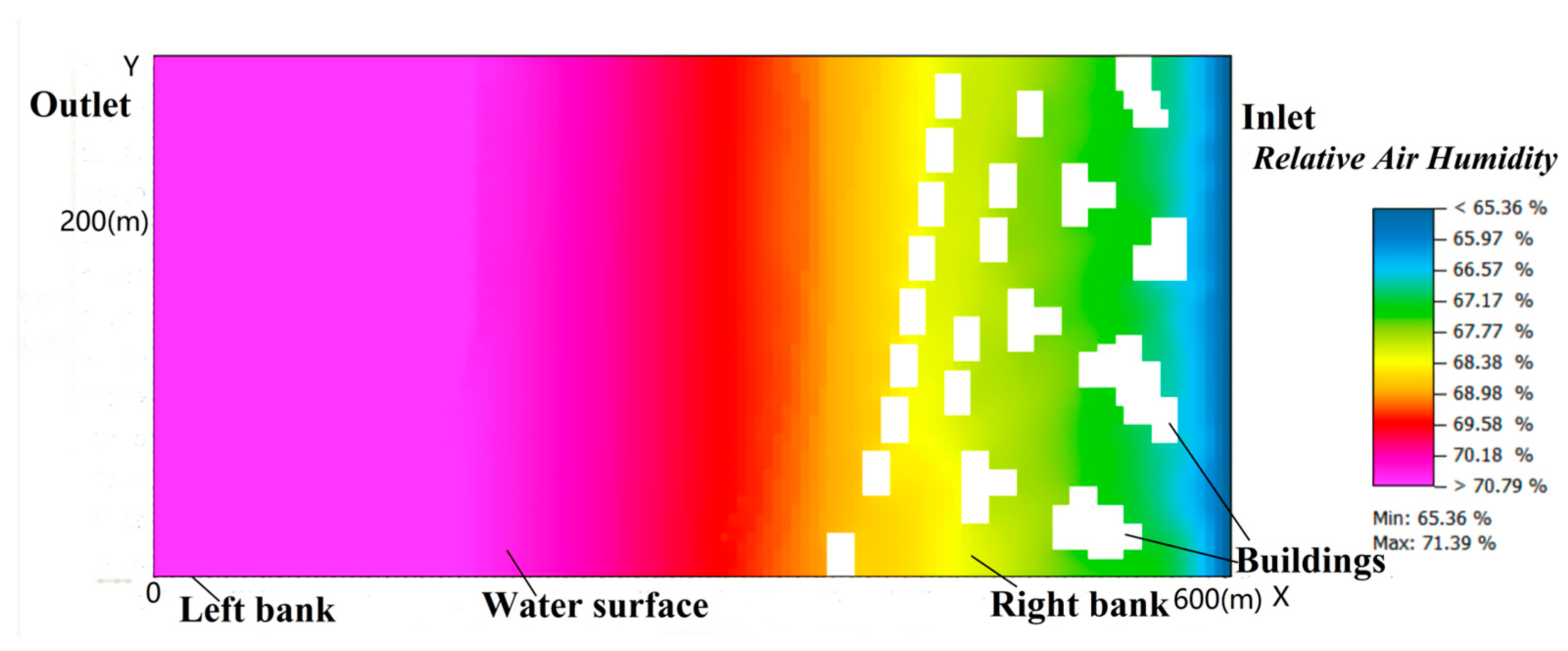
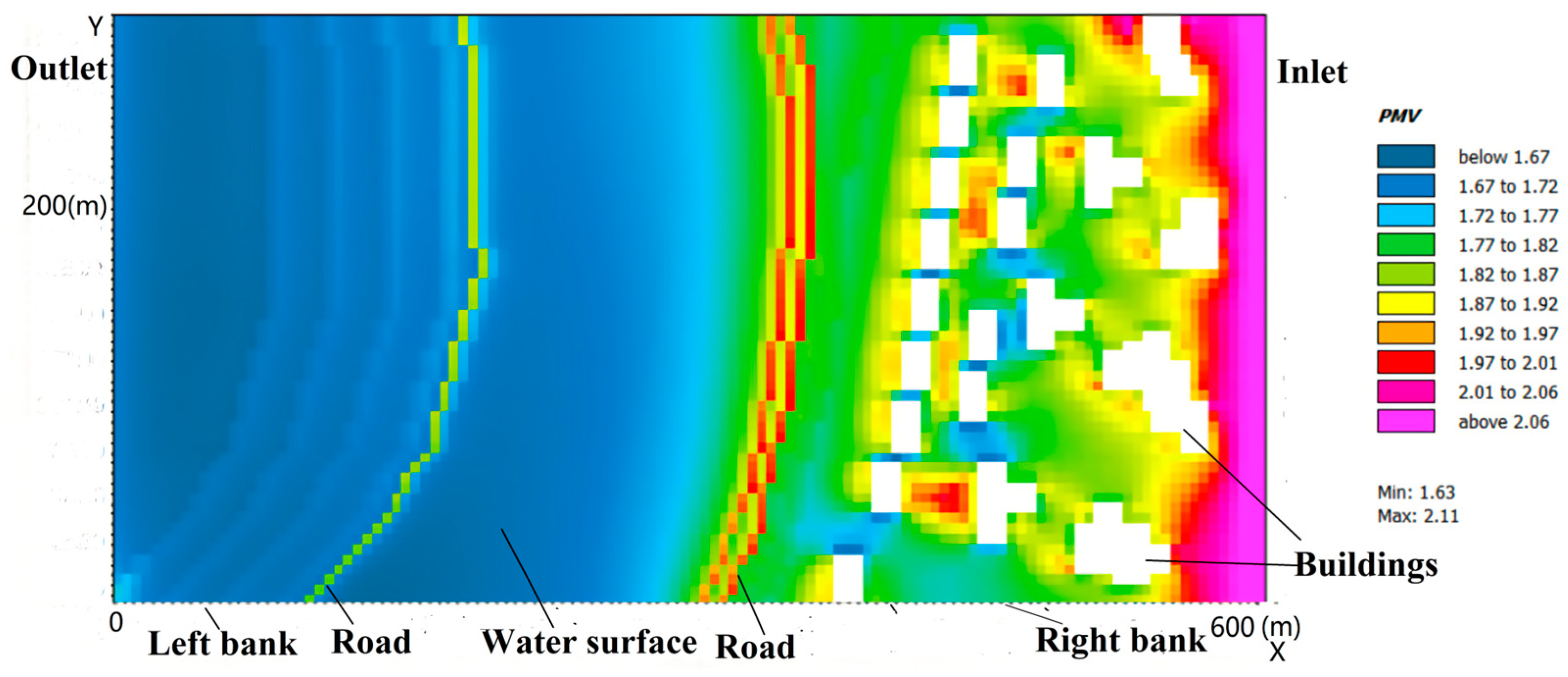
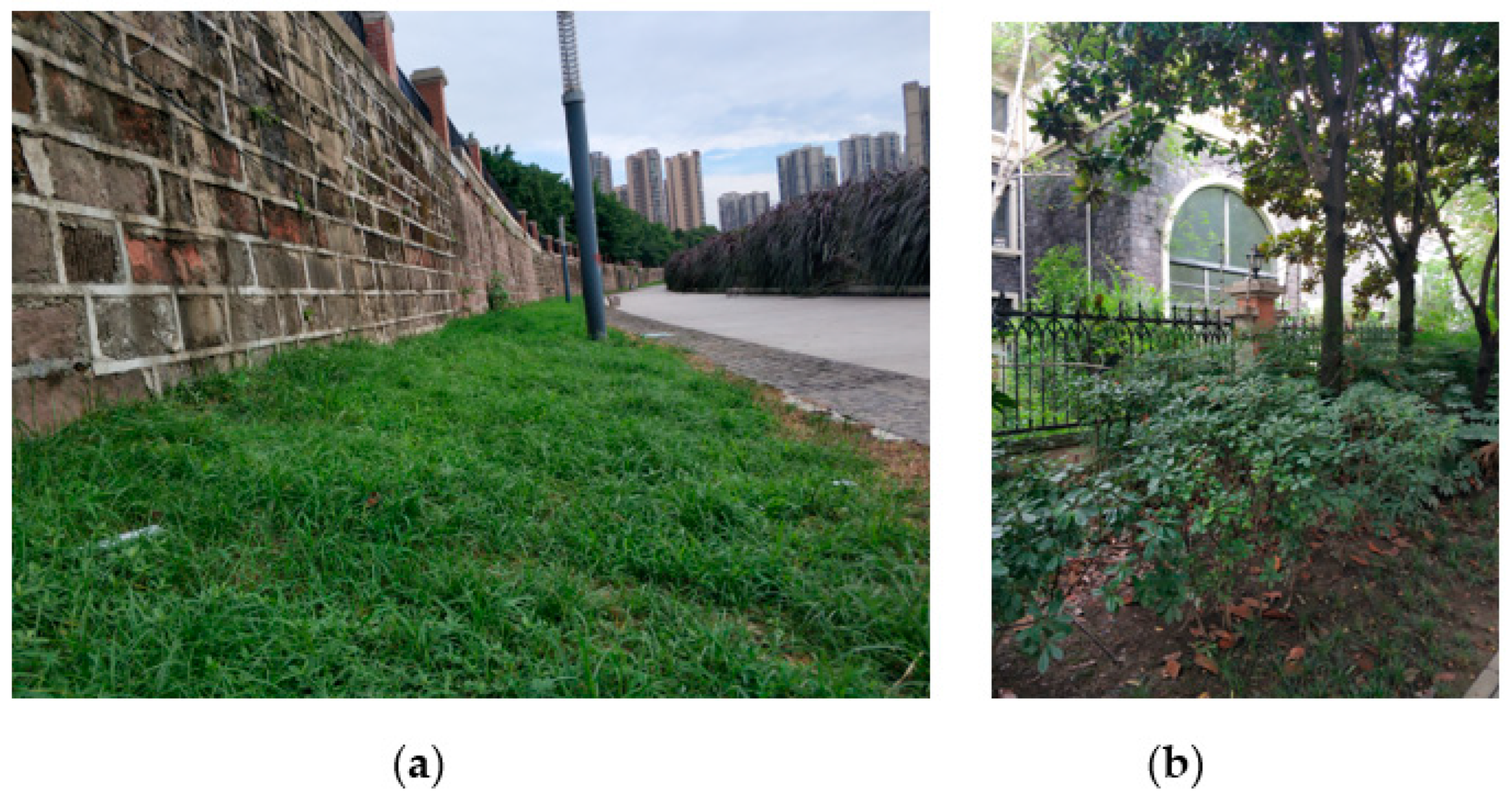
| Time | Solar Radiation Intensity (W/m2) | Air Temperature (°C) | Relative Air Humidity (%) |
|---|---|---|---|
| 7:00 | 75.82 | 27.28 | 90.60 |
| 8:00 | 130.19 | 28.69 | 86.67 |
| 9:00 | 74.92 | 29.89 | 79.85 |
| 10:00 | 49.80 | 30.22 | 78.57 |
| 11:00 | 90.94 | 29.94 | 79.08 |
| 12:00 | 285.99 | 30.19 | 76.95 |
| 13:00 | 646.91 | 30.75 | 73.27 |
| 14:00 | 471.55 | 31.82 | 70.51 |
| 15:00 | 800.08 | 33.16 | 60.08 |
| 16:00 | 191.87 | 34.76 | 61.30 |
| 17:00 | 247.59 | 33.78 | 65.47 |
| 18:00 | 173.75 | 33.03 | 67.29 |
| 19:00 | 76.48 | 32.25 | 70.99 |
| Length (m) | 600 | Width (m) | 300 |
| Grid size (m) | 2 | Expansion coefficient | 20% |
| The lowest height of the building (m) | 140 | ||
| Simulation Duration (h) | 24 |
| Air temperature (°C) | Min: 27.28 Max: 34.76 |
| Relative air humidity (%) | Min: 60.08 Max: 90.60 |
| Solar radiation intensity (W/m2) | Max: 800.08 |
| Wind speed (m/s) | 1.21 |
| Soil temperature (°C) | 19.85 |
| Soil moisture (%) | 70.00 |
| Surface roughness | 0.02 |
| 9:00 | 12:00 | 16:00 | |||||||
|---|---|---|---|---|---|---|---|---|---|
| Measuring Point | Measured Value (°C) | Simulation Value (°C) | RE (%) | Measured Value (°C) | Simulation Value (°C) | RE (%) | Measured Value (°C) | Simulation Value (°C) | RE (%) |
| 1 | 25.3 | 26.1 | 3.16 | 27.5 | 26.5 | 3.64 | 30.9 | 30.5 | 1.29 |
| 2 | 25.6 | 25.7 | 0.39 | 27.4 | 26.7 | 2.55 | 30.6 | 30.9 | 0.98 |
| 3 | 25.7 | 25.2 | 1.95 | 28.3 | 27.1 | 4.24 | 31.0 | 31.5 | 1.61 |
| 4 | 26.4 | 25.9 | 1.89 | 27.3 | 26.4 | 3.30 | 30.2 | 31.1 | 2.98 |
| 5 | 25.8 | 25.6 | 0.78 | 27.1 | 26.9 | 0.74 | 29.7 | 29.4 | 1.01 |
| 6 | 25.2 | 24.6 | 2.38 | 27.3 | 26.4 | 3.30 | 29.4 | 29.2 | 0.68 |
| 9:00 | 12:00 | 16:00 | |||||||
|---|---|---|---|---|---|---|---|---|---|
| Measured Value (%) | Simulation Value (%) | RE(%) | Measured Value (%) | Simulation Value (%) | RE (%) | Measured Value (%) | Simulation Value (%) | RE (%) | |
| 1 | 75.9 | 73.4 | 3.29 | 67.6 | 69.2 | 2.37 | 60.8 | 60.4 | 0.66 |
| 2 | 70.4 | 71.5 | 1.56 | 69.2 | 68.8 | 0.58 | 62.5 | 64.9 | 3.84 |
| 3 | 71.5 | 71.9 | 0.56 | 68.9 | 69.3 | 0.58 | 57.1 | 59.1 | 3.50 |
| 4 | 72.7 | 71.5 | 1.65 | 70.1 | 69.7 | 0.57 | 61.8 | 61.3 | 0.81 |
| 5 | 71.6 | 73.4 | 2.51 | 68.8 | 70.6 | 2.62 | 60.2 | 62.6 | 3.99 |
| 6 | 76.7 | 73.9 | 3.65 | 72.8 | 69.6 | 4.40 | 59.8 | 59.5 | 0.50 |
Disclaimer/Publisher’s Note: The statements, opinions and data contained in all publications are solely those of the individual author(s) and contributor(s) and not of MDPI and/or the editor(s). MDPI and/or the editor(s) disclaim responsibility for any injury to people or property resulting from any ideas, methods, instructions or products referred to in the content. |
© 2023 by the authors. Licensee MDPI, Basel, Switzerland. This article is an open access article distributed under the terms and conditions of the Creative Commons Attribution (CC BY) license (https://creativecommons.org/licenses/by/4.0/).
Share and Cite
Qi, X.; Zhao, X.; Fu, B.; Xu, L.; Yu, H.; Tao, S. Numerical Study on the Influence of Rivers on the Urban Microclimate: A Case Study in Chengdu, China. Water 2023, 15, 1408. https://doi.org/10.3390/w15071408
Qi X, Zhao X, Fu B, Xu L, Yu H, Tao S. Numerical Study on the Influence of Rivers on the Urban Microclimate: A Case Study in Chengdu, China. Water. 2023; 15(7):1408. https://doi.org/10.3390/w15071408
Chicago/Turabian StyleQi, Xuejun, Xing Zhao, Bin Fu, Lanjing Xu, Haibin Yu, and Shuyan Tao. 2023. "Numerical Study on the Influence of Rivers on the Urban Microclimate: A Case Study in Chengdu, China" Water 15, no. 7: 1408. https://doi.org/10.3390/w15071408





